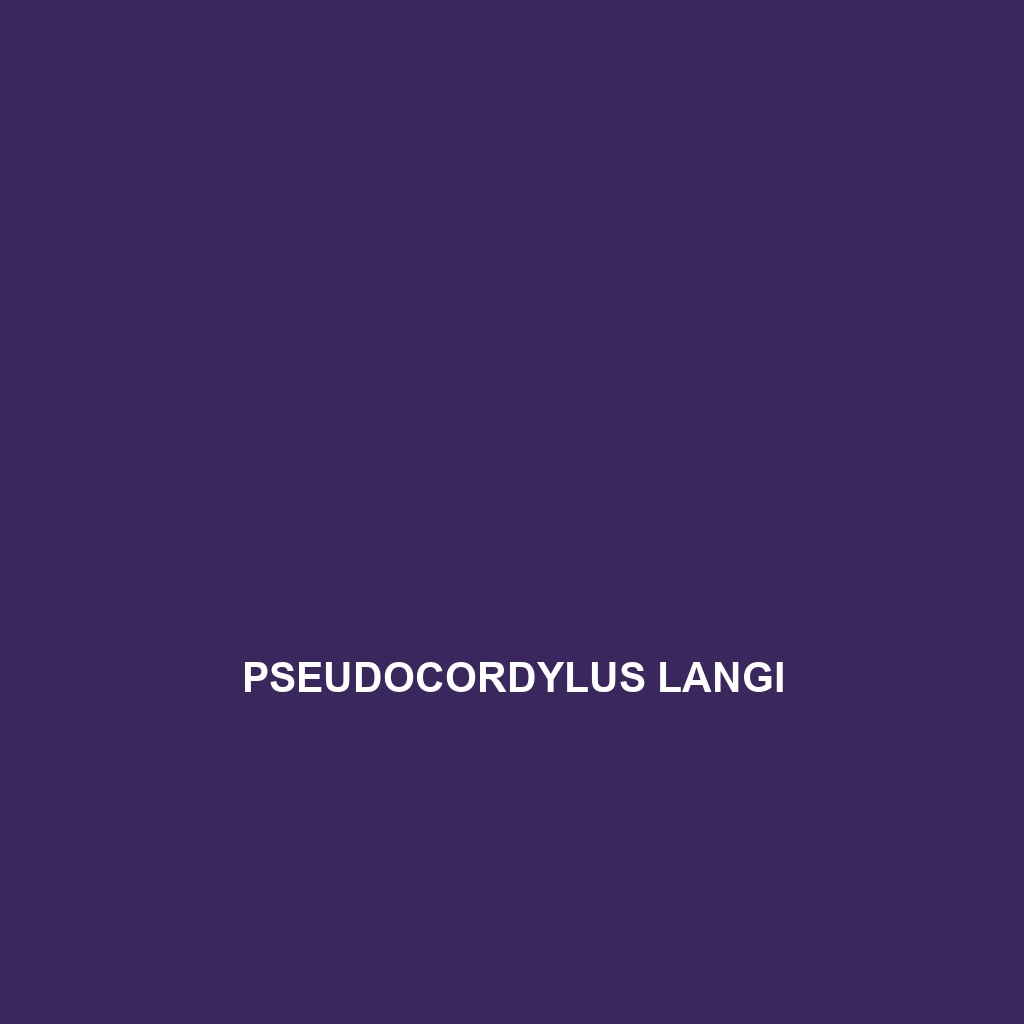Common Name
Pseudocordylus langi
Scientific Name
Pseudocordylus langi
Habitat
Pseudocordylus langi, commonly known as Lang’s girdled lizard, is primarily found in the temperate forests and grasslands of southern Africa, particularly in regions such as South Africa and Lesotho. These lizards thrive in areas characterized by rocky terrains, where they make their homes in crevices and under stones. The climate in these habitats typically includes warm summers and cool winters, with considerable rainfall that supports diverse flora. The lizard is often found in proximity to grasslands and bushveld, utilizing the dense vegetation for shelter and hunting. These habitats are crucial for their survival as they provide not just shelter, but an abundance of food sources and suitable conditions for breeding.
Physical Characteristics
Pseudocordylus langi is a strikingly unique species of lizard, typically measuring between 15 to 20 centimeters in length. One of its most distinct features is its robust body covered with a mosaic of scales that often exhibit cryptic coloration, helping it blend seamlessly into rocky backgrounds. The lizard’s coloration ranges from shades of brown and gray to more vibrant greens, enabling it to remain inconspicuous from predators. The dorsal side displays a pattern of lighter spots or banding, which aids in camouflage. Additionally, they have a characteristic flattened body shape, which allows for easier movement through tight spaces in rocky environments. Their limbs are strong but short, ending in sharp claws, providing stability and grip on uneven surfaces.
Behavior
Pseudocordylus langi is primarily diurnal, meaning it is most active during the daytime. They exhibit interesting social interactions, often found basking on sunlit rocks in small groups, although they can be territorial. These lizards are known for their unique defensive behavior; when threatened, they can puff up their bodies and display a series of hissing sounds to ward off predators. During the mating season, which usually occurs in the warmer months, males engage in elaborate displays of strength and color to attract females. The lizards also exhibit a remarkable ability to climb, taking advantage of vertical surfaces, which aids in both foraging for food and avoiding danger.
Diet
The diet of Pseudocordylus langi primarily consists of insects, making them insectivores. They have a particular preference for ants, termites, and small beetles, using their keen eyesight to spot prey among the leaf litter and rocks. Feeding typically occurs in the morning hours when temperatures are cooler, providing an ideal time to hunt. Their feeding strategy involves stealth and rapid strikes to catch their prey, showcasing their agility and speed. This dietary habit not only plays a crucial role in their survival but also contributes to controlling insect populations in their ecosystem.
Reproduction
The reproductive cycle of Pseudocordylus langi is fascinating. Breeding generally occurs during the spring and summer months when temperatures rise. After a courtship display, females will lay clutches of about 4 to 8 eggs, typically in sandy soil or under debris for protection. The incubation period lasts around 60 to 80 days, during which the eggs are kept moist and protected from potential threats. Hatchlings are small but fully formed and relatively independent at birth, quickly dispersing to find their own habitat and food sources. Parental care is minimal in this species, as the focus shifts to individual survival.
Conservation Status
According to the International Union for Conservation of Nature (IUCN), Pseudocordylus langi is currently classified as Least Concern. Despite this stable status, the species faces challenges such as habitat destruction due to urbanization and agricultural expansion. Conservation efforts are underway in some areas to protect their habitats and ensure the sustainability of their populations. However, ongoing monitoring is necessary to prevent potential threats stemming from environmental changes.
Interesting Facts
One of the most intriguing aspects of Pseudocordylus langi is its remarkable ability to adapt to its environment. They have a unique method of thermoregulation; they bask on sunny rocks to elevate their body temperature, crucial for their metabolic functions. Additionally, their scales have evolved to be extremely resilient, providing protection against desiccation and predation. This lizard is also known for its ability to change color slightly in response to environmental factors, further enhancing its camouflage capabilities.
